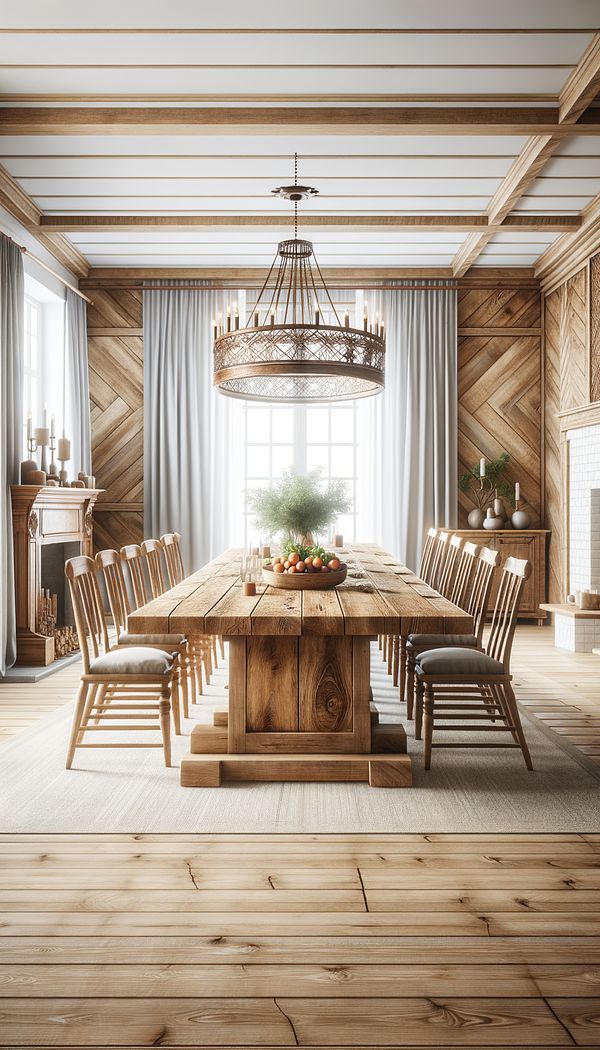What is a Harvest Table?
A harvest table is a large, typically rectangular table known for its simple and sturdy design.
Description
A harvest table, harking back to the late 19th and early 20th centuries, represents more than just a piece of furniture; it symbolizes a piece of history where families and communities gathered to share meals and celebrate the harvest season. Traditionally made from solid wood, these tables boast a rustic aesthetic, featuring straightforward lines and an unadorned surface that pay homage to their utilitarian origins. The sturdiness and simplicity of the design have allowed these tables to stand the test of time, both physically and stylistically.
In contemporary interior design, harvest tables have found a place in various settings, from traditional to modern homes, thanks to their versatility. They serve not only as dining tables but also as spacious work surfaces in home offices or craft rooms. The natural wood finish typically seen on harvest tables complements a wide range of interior styles, including farmhouse, rustic, and shabby chic, while also blending seamlessly into more modern and minimalist decors.
The enduring popularity of harvest tables reflects a broader trend towards pieces that evoke a sense of history and authenticity in interior design. Their substantial size and solid construction make them a practical choice for families, while their timeless aesthetic appeals to those looking to add a touch of warmth and character to their homes.
Usage
Harvest tables are often seen in homes that embrace a warm, inviting aesthetic. They're commonly used as the primary dining table in the kitchen or dining room, offering ample space for family gatherings and entertaining guests. In addition to their use in residential settings, harvest tables are also popular in communal spaces such as cafes and studios, where their large size and durable construction make them well-suited for shared activities.
FAQs
-
Can a harvest table be used in a modern interior design scheme?
Absolutely! While harvest tables originate from a more rustic and traditional aesthetic, their simple lines and solid construction make them adaptable to modern and minimalist interiors as well. Pairing a harvest table with contemporary chairs or modern decor can create an intriguing blend of old and new.
-
How do you care for a wooden harvest table?
Caring for a wooden harvest table involves regular dusting and cleaning with a damp cloth. Avoid using harsh chemicals or abrasive materials that can damage the wood surface. Periodically treating the wood with a suitable oil or wax can help protect the table and maintain its natural beauty.
-
Are all harvest tables made from wood?
While traditional harvest tables are primarily made from solid wood, contemporary versions may incorporate other materials such as metal for the legs or bases, adding a modern twist to the classic design. However, the characteristic feature of a harvest table is its wooden tabletop, and most authentic versions maintain this tradition.
Practical Application
When incorporating a harvest table into your home, consider the overall aesthetic you wish to achieve. Its large size can make it a focal point of the room, so pairing it with the right seating and decor is crucial. For a cohesive look, match the table with other wood finishes in the room or introduce contrasting elements for a more eclectic style. In terms of seating, benches can complement the rustic feel of the table, while modern chairs can offer a contemporary twist.
-
Design Styles478 articles
-
Furniture Types599 articles
-
Decorative Objects240 articles
-
Decorating Principles & Elements330 articles
-
Materials & Textiles360 articles
-
FixtureIn interior design, fixtures refer to items that are attached to the property in a way that makes them a permanent part of the space.
-
IlluminanceIlluminance is the measure of how much light falls on a surface.
-
Drum DyeingDrum dyeing is a leather coloring process where hides are tumbled in a rotating drum with dye solutions.
-
Viscoelastic FoamViscoelastic foam is a type of polyurethane foam known for its ability to mold to the body in response to heat and pressure.
-
Chaise LongueA long chair designed for lounging with the legs extended.
